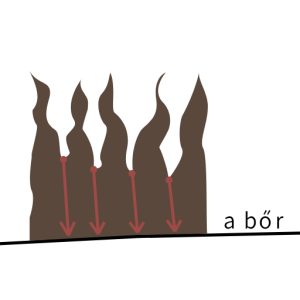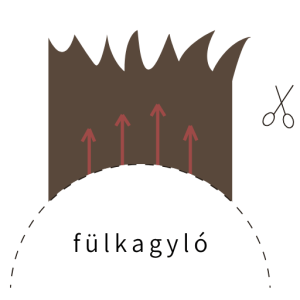Grooming and Care
Puli Grooming for Beginners
The task of dog grooming is the professional cleaning and care of dogs, as well as trimming, clipping, and brushing the coats of dogs competing in exhibitions to emphasize breed characteristics (while concealing minor anatomical flaws).
Dog grooming should be done on a table, and the puli can be accustomed to this. It is very important that the animal experiences this activity as a comforting, pleasant, and familiar experience. When working with a young dog, it is essential to use patience and praise to help them get accustomed.
Puppy Puli
With their coat, there isn't much to do for a while, other than keep it reasonably clean. If it's not necessary, avoid bathing them. Make sure they receive high-quality food and are free from fleas and intestinal worms.
The first "shedding" of a young Puli's coat can take place between 6-10 months of age, depending on the inherited quality of the fur. You'll notice when the undercoat has started to weave into the spiral or wavy guard hairs, and a firmer, more structured coat begins to form, replacing the puppy coat.
This coat structure splits lengthwise, similar to canvas. Using this characteristic, we create the very attractive corded or ribbon-like coat.

The puli can be worked on beautifully while lying on its side on the table. Start tearing the fur in a row, for example, from the nose towards the tail, or from the paws towards the spine.
We should take into account the natural thickness of the strands, but avoid thinning them to less than the width of a thumb, as they will later become compacted and tangled.
On the head and legs, thinner strands often naturally form, and these should definitely not be further halved. We can keep our hands moist, making it easier to collect the fallen undercoat hairs.
The skin of the ear canal is very delicate and can easily tear! The fur here contains more undercoat hairs and is harder to split. Therefore, when plucking the ear fur, use scissors and pull or cut the fur away from the skin.
Along the spine, from the withers to the croup, we create a parting to ensure the backline is clearly visible.

General Grooming
Eye Care
Clean the corners of the eyes with a cotton ball or gauze pad dampened with lukewarm water or boric water. If there is mucous (white or yellow) discharge, consult a veterinarian..Outer Ear Care
The hairs growing in the outer ear canal should be regularly removed. The frequency depends on the quality of the dog's coat. Perform this task when the overgrown hair begins to obstruct natural ventilation and cleaning. Removing hair from the ear canal is uncomfortable for the animal! Impatient, forceful, or rough handling will permanently complicate this grooming task. With gentle and repeated attempts, the dog may eventually tolerate the procedure. Gently pull the ear flap slightly back and upward, then use your thumb and index finger to reach into the ear canal and remove the fine hairs in small sections. Blunt-ended hemostatic tweezers can also be used, but another person must securely hold the dog's head to avoid accidents. The ear canal should also be cleaned. Apply ear cleaner to a gauze pad wrapped around your finger and carefully clean the ear canal and the small folds of the ear flap. A cotton ball held in hemostatic tweezers can also be used if the dog is restrained. If you notice a large amount of brown discharge and/or the dog is scratching its ears, consult a veterinarian.Muzzle Care
Avoid feeding watery food to the Puli. The fur around its mouth can only be properly cleaned by soaking, which is not feasible daily and is unpleasant for the dog. If you are not feeding commercial food but preparing homemade meals, it is advisable to trim the fur around the mouth. Trim the hair hanging between the lips. The fur extending beyond the nose should be trimmed around the nostrils.Care of the Anus and Genitals
Keep the hair in these areas trimmed short. The anal glands around the anus should be periodically emptied. This procedure can be performed by a professional groomer or veterinarian, and owners can learn to do it themselves.Paw Care
Trim overgrown hair on the pads and between the toes using scissors, shaping the fur around the nails into a round form while leaving it intact. Nails may need trimming if they do not wear down naturally. As nails contain blood vessels and nerves, nail trimming should only be performed by an experienced individual using appropriate nail clippers. Dry, cracked paw pads can be treated with silicone hand cream or paw balm designed for dogs.Bathing
The frequency of bathing should take into account several factors, such as: The type of terrain the dog walks on. Whether the dog enters the house (or even the furniture). Whether the dog is preparing for a show. Recent events such as being in heat, giving birth, or having diarrhea. The dog should be bathed when necessary, as determined by the owner. Before bathing, untangle the unkempt coat, remove plant debris, and empty the anal glands. The Puli should be effectively bathed by preparing a large quantity of shampoo-laden standing water (deep enough to reach the neck) and soaking the dog in it. If needed, repeat the soaking process. After soaking, use diluted shampoo to clean the dirtier areas, such as the muzzle, the area under the ear flaps, the chest coat, the anus, genitals, and paws. Do not rub the forming cords of a young Puli during bathing! Finally, thoroughly rinse the dog. For pre-show bathing, a diluted beer rinse will result in the desired coat condition. For dirty, greasy coats, use WU-2 shampoo; for mildly soiled coats, use a regular herbal shampoo; and for puppies, use baby shampoo. After bathing, wring out the coat from top to bottom in a circular motion. Lay the dog on a towel and use additional dry towels to press out water in sections. You can also use a hair dryer during this process. For an adult dog with a full coat, drying may need to be repeated multiple times over 24 hours. Except in warm weather, do not allow the dog outside while its coat is still wet. Following bathing, trim the nails and treat the paws and pads. While still damp or after drying, comb the coat again. It may take several days for the coat to regain its original shape, which should be considered when preparing for a show. Parasitic baths (using Neostomosan or Neocidol) should only be performed on neglected, flea-infested dogs. After shampooing, apply the solution and allow it to dry. For tangled or matted Puli coats, breed-specific trimming is necessary. In this case, use a sharp, straight-edged, short-bladed pair of scissors. Assess the length of hair that can be left, which may be as short as 2 cm. This is preferable to shaving with clippers, as the dog also physiologically needs its coat. Complete shaving should only be performed in exceptional cases. Divide matted hair into sections, trim them with scissors, and pull the hair outward and backward from the skin. Remove any loose fluff hairs. Where the trimmed hair does not separate, use scissors to split it. According to breed standards, the Puli's coat should cover its eyes! After general grooming, bathing, and drying, trim the head fur into a rounded shape and the body and leg fur into cylindrical shapes. Shape the young Puli's form as needed.Housing Conditions and Feeding
To ensure that the Puli puppy's hereditary coat quality (and other physical and mental traits) develops as intended, proper feeding and living conditions are essential. The dog is a carnivore. It should receive food specifically formulated for dogs. There are excellent skin and coat supplements available, which are worth using. Regularly treat for external and internal parasites. The most suitable flea control products for Pulik are "spot-on" treatments such as Frontline, Ex-spot, or Advantage. Deworming should be handled by a veterinarian. The eyes, ears, and anal glands should be regularly maintained. The Puli's living space must be kept clean, and weeds such as thistles, foxtails, and seeds should be removed from the garden.Source: Erika Szentes, Certified Dog Groomer

Regulations
- Regulations
- Privacy Policy
- Articles of Association
- Ethics and Disciplinary Regulations
- Report
- Legal Notice, copyright information.
Follow us
puli.hu is an amazing website! Filled with wonderful pictures of Pulik, entertaining videos, and interesting content that will make every Puli fan's heart race.
Kiss Anna
© 2024 | All rights reserved | puli.hu | Powered by: MLZA.